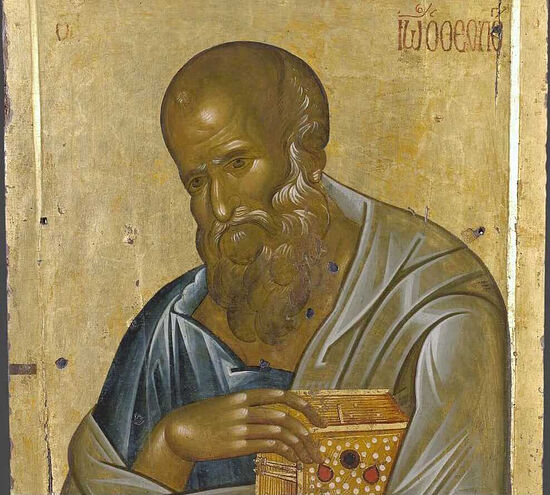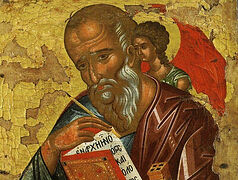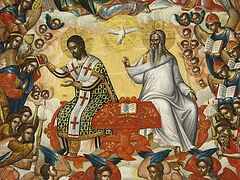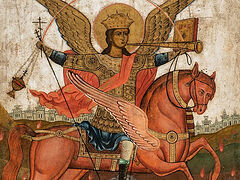Talk 5. The “Encrypted” Language of Revelation
In the following article, Sergei Komarov, a well-known Orthodox writer and catechist based in Moscow, examines the Russian Synodal translation of Scripture (published in full in 1876 under the editorship of St. Philaret, the Metropolitan of Moscow) as compared to the Hebrew and Greek texts. This analysis, written originally for a Russian audience, should nevertheless prove interesting to an English-speaking audience as well.
***
In this article, we will try to examine the meaning of the complex formula that St. John the Theologian uses to denote God Himself. The apostle conveys grace and peace to his addressee from Him Which is, and Which was, and Which is to come; and from the seven Spirits Which are before his throne; And from Jesus Christ (Rev. 1:4-5).
St. John speaks of God, but he does not speak the language of the Cappadocian Fathers, nor the language of the late Patristics. His speech is strange for us; we are not used to speaking of God this way.
Let’s begin with the phrase Which is, and Which was, and Which is to come. In Greek it reads as “ο ων και ο ην και ο ερχόμενος.”
St. Andrew of Caesarea offers three interpretations of this form:
1. Here we are talking about the Trinity, namely:
-
ό ών – the Father, Who spoke to Moses: έγώ εΐμι ό ών (Ex. 3:14)—I AM THAT I AM;
-
ό ην – Christ, God the Word, of Whom the Gospel says: ὁ λόγος ἠ̃ν πρòς τòν θεόν—the Word was with God (Jn. 1:1);
-
ό ερχόμενος – the Holy Spirit, Who descends upon the children of the Church in holy Baptism.
2. St. Andrew cites the view of St. Gregory the Theologian, who understood this whole construction as referring to the Son of God: “Blessed Gregory the Theologian relates the expression, Which was, and Which is to come, the Almighty, to Christ.
3. “By the expression, Which is, and Which was, and Which is to come, he means the Father, Who contains within Himself the beginning, middle, and end of the existence [being] of all things.”
This latter interpretation, in our opinion, takes precedent. It is followed by such scholars as A. A. Zhdanov and Archpriest Sergei Bulgakov. The logic of this interpretation is that, in the end, the entire phrase, from Him Which is, and Which was, and Which is to come; and from the seven Spirits Which are before his throne; And from Jesus Christ, will point to the Most Holy Trinity.
Fr. Sergei Bulgakov, a very liberal and sometimes even heretical interpreter of Revelation, makes a good point here, which is quite acceptable:
“The eternity of God is here expressed as encompassing all time, or being above time, by the grammatical combination of all three tenses: the present, past, and future.” Let us the clarify the thought of Fr. Sergei: In the Greek text there is no future tense, but a hint at it: ο ερχόμενος (literally translated as “the Coming One,” but it can be understood as “having to come”).
There’s a wonderful interpretation of this from the outstanding Biblicist of our day (alas, already reposed), Archimandrite Iannuary (Ivliev). He says that we have before us the expansion and development of the name of God, “Yahweh.”
“This name of God is the development of that great name, forbidden to be pronounced, that was revealed to Moses at the Burning Bush (cf. Ex. 3:14). That revelation to Moses was not simply about the existence of God or the eternity of His existence, but the presence of God among and for His people.”
Let’s examine the thought of Fr. Iannuary. In the third chapter of the book of Exodus, Moses asks God at the Burning Bush what His name is. God answers Moses:
I AM THAT I AM: and He said, Thus shalt thou say unto the children of Israel, I AM hath sent me unto you.
Note that, in the popular Russian Synodal translation, the word “Jehovah (Иегова)” was added for some reason. In the original Hebrew text, there is something quite different. God answers Moses: Ehyeh ašer ehyeh.1 And He said: Thus shalt thou say unto the children of Israel, Ehyeh hath sent me unto you.
Here is Ex. 3:14 in the Hebrew:
• וַיֹּאמֶר אֱלֹהִים אֶל־מֹשֶׁה אֶהְיֶה אֲשֶׁר אֶהְיֶה וַיֹּאמֶר כֹּה תֹאמַר לִבְנֵי יִשְׂרָאֵל אֶהְיֶה שְׁלָחַנִי אֲלֵיכֶם׃
The Russian Synodal translation reads: God said to Moses, I Am the Existing One. And He said: Thus say to the sons of Israel: The Existing One [Jehovah (Иегова)] hath sent me to you.
I have marked the name of God in bold in both the Hebrew and Russian texts. In the first, the formula: “I AM THAT I AM,” and in the second: “The Existing One.” Let’s examine both versions.
1
אֶהְיֶה אֲשֶׁר אֶהְיֶה – Ehyeh ašer ehyeh, “I AM THAT I AM/The Existing One.” Literally: “I will be Who I will be.” Another possible translation is: “I Am Who I Am.” The Synodal translation reads: “I Am the Existing One” (in Greek: ὁ ὤν).
As you can see, the Synodal translation is based on the Greek translation, which can be called rather experimental. In the language of the original, there is no present participle of the verb “to be.” It says there: “I will be Who I will be.”
2
• אֶהְיֶה – Ehyeh, “The Existing One.” Literally: “I will be.” It could also be translated as “I AM.”
It’s significant that the Lord Jesus often applied to Himself the formula “I Am”—the equivalent of the name of God (cf., for example, Jn. 8:24, 28, 58, 13:19, 18:5-6).
Thus, God is called here אֶהְיֶה אֲשֶׁר אֶהְיֶה – “I Am the Existing One.” Literally: “I will be Who I will be;” and also אֶהְיֶה – “The Existing One.” Literally: “I will be.”
Now let’s look at Ex. 3:15, where there appears the Tetragrammaton—the four sacred letters [YHWH—Trans.] signifying the name of God. We don’t know how to pronounce it correctly, but we presume it’s “Yahweh.” It’s translated incorrectly in the Synodal translation as “Jehovah (Иегова).”2
Here’s the text:
• וַיֹּאמֶר עֹוד אֱלֹהִים אֶל־מֹשֶׁה כֹּה־תֹאמַר אֶל־בְּנֵי יִשְׂרָאֵל יְהוָה אֱלֹהֵי אֲבֹתֵיכֶם אֱלֹהֵי אַבְרָהָם אֱלֹהֵי :
I put the name of God, “Yahweh,” in bold. In the Synodal translation, this name as translated as “the Lord.”
• יְהוָה – Yahweh (“He is,” “He is present”).
The Synodal translation:
And God again said unto Moses: Thus say unto the sons of Israel: The Lord, the God of your fathers, the God of Abraham, the God…
When we translate Yahweh as “He is (Он есть),” we don’t mean the way it’s used in a phrase like, “I am a man (Я есть человек).” It would be more correct in a phrase like, “I have an apple (у меня есть яблоко).”3 That is, in this name, the Lord highlights His presence in history, in the life of the people of God.
Thus, in Ex. 3:14 and 15, the name of God is given in three forms:
-
Ehyeh ašer ehyeh
-
Ehyeh
-
Yahweh
The first and second are given in the first person (when God speaks of Himself), and the third in the third person (when someone else speaks about God). The second is an abbreviation of the first. You can translate them like this: The first form – “I will be present the way I will be present;” the second form – “I will be present;” and the third – “The Present One” or “He is present.”
Rephrasing it, we can say that the name of God is “God is with us” (which is the meaning of “Emmanuel”). And I think that the phrase from Revelation: “ο ων – Which is, και – and, ο ην – Which was, και – and ο ερχόμενος – Which is to come”—is an extension of the name Yahweh. By the way, this is how the Palestinian interpretations of Ex. 3:14 paraphrase the name of God: “I Am Who was and will be.”
Archimandrite Iannuary (Ivliev) writes:
Similar formulas were applied by the Greeks to the supreme deity or even just to the gods. Some of them have come down to us from the pagan world. For example, one ancient oracle says: “Zeus was, Zeus is, Zeus will be.” The followers of the Orphic religion said: “Zeus is the first, and Zeus is the last; Zeus is the head, and Zeus is the middle, and from Zeus came all things.” All of this received such a beautiful expression in Heb. 13:8: Jesus Christ the same yesterday, and to day, and for ever. But for all the similarities with this Greek formula, it is obvious that the name used by St. John differs significantly from it.
St. John interprets the Divine name dynamically, not as an indication of His transcendent eternity without relation to the world (Being), but as His eternity in relation to the world. This is how the Biblical God comes to His creation.
And we can append to the distinguished professor: As God was present in the life of Israel (“He is”), so He is present in the life of Christians, the New Israel.
But what is the meaning of the rest of the construction, from Him Which is, and Which was, and Which is to come; and from the seven Spirits Which are before his throne; And from Jesus Christ?
We will learn about this in the next article.
To be continued…




